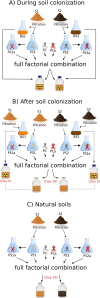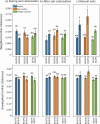Impact of phages on soil bacterial communities and nitrogen availability under different assembly scenarios
- PMID: 32252805
- PMCID: PMC7137350
- DOI: 10.1186/s40168-020-00822-z
Impact of phages on soil bacterial communities and nitrogen availability under different assembly scenarios
Abstract
Background: Bacteriophages, the viruses infecting bacteria, are biological entities that can control their host populations. The ecological relevance of phages for microbial systems has been widely explored in aquatic environments, but the current understanding of the role of phages in terrestrial ecosystems remains limited. Here, our objective was to quantify the extent to which phages drive the assembly and functioning of soil bacterial communities. We performed a reciprocal transplant experiment using natural and sterilized soil incubated with different combinations of two soil microbial communities, challenged against native and non-native phage suspensions as well as against a cocktail of phage isolates. We tested three different community assembly scenarios by adding phages: (a) during soil colonization, (b) after colonization, and (c) in natural soil communities. One month after inoculation with phage suspensions, bacterial communities were assessed by 16S rRNA amplicon gene sequencing.
Results: By comparing the treatments inoculated with active versus autoclaved phages, our results show that changes in phage pressure have the potential to impact soil bacterial community composition and diversity. We also found a positive effect of active phages on the soil ammonium concentration in a few treatments, which indicates that increased phage pressure may also be important for soil functions.
Conclusions: Overall, the present work contributes to expand the current knowledge about soil phages and provide some empirical evidence supporting their relevance for soil bacterial community assembly and functioning. Video Abstract.
Conflict of interest statement
The authors declare that they have no competing interests.
Figures





Similar articles
-
Interactions between bacterial and phage communities in natural environments.Nat Rev Microbiol. 2022 Jan;20(1):49-62. doi: 10.1038/s41579-021-00602-y. Epub 2021 Aug 9. Nat Rev Microbiol. 2022. PMID: 34373631 Review.
-
Long-term soil metal exposure impaired temporal variation in microbial metatranscriptomes and enriched active phages.Microbiome. 2018 Dec 13;6(1):223. doi: 10.1186/s40168-018-0606-1. Microbiome. 2018. PMID: 30545417 Free PMC article.
-
Bacteriophage-Bacteria Interactions Promote Ecological Multifunctionality in Compost-Applied Soils.Environ Microbiol. 2025 Mar;27(3):e70074. doi: 10.1111/1462-2920.70074. Environ Microbiol. 2025. PMID: 40109201
-
The impact of bacteriophages on phyllosphere bacterial abundance and composition.Mol Ecol. 2018 Apr;27(8):2025-2038. doi: 10.1111/mec.14542. Epub 2018 Mar 15. Mol Ecol. 2018. PMID: 29457297
-
The role of rhizosphere phages in soil health.FEMS Microbiol Ecol. 2024 Apr 10;100(5):fiae052. doi: 10.1093/femsec/fiae052. FEMS Microbiol Ecol. 2024. PMID: 38678007 Free PMC article. Review.
Cited by
-
Soil viral diversity, ecology and climate change.Nat Rev Microbiol. 2023 May;21(5):296-311. doi: 10.1038/s41579-022-00811-z. Epub 2022 Nov 9. Nat Rev Microbiol. 2023. PMID: 36352025 Review.
-
Rhizosphere phage communities drive soil suppressiveness to bacterial wilt disease.Microbiome. 2023 Feb 1;11(1):16. doi: 10.1186/s40168-023-01463-8. Microbiome. 2023. PMID: 36721270 Free PMC article.
-
Element cycling by environmental viruses.Natl Sci Rev. 2024 Dec 23;11(12):nwae459. doi: 10.1093/nsr/nwae459. eCollection 2024 Dec. Natl Sci Rev. 2024. PMID: 39791124 Free PMC article. No abstract available.
-
The highly diverse antiphage defence systems of bacteria.Nat Rev Microbiol. 2023 Oct;21(10):686-700. doi: 10.1038/s41579-023-00934-x. Epub 2023 Jul 17. Nat Rev Microbiol. 2023. PMID: 37460672 Review.
-
Isolation of Bacteriophages from Soil Samples in a Poorly Equipped Field Laboratory in Kruger National Park.Methods Mol Biol. 2024;2738:91-103. doi: 10.1007/978-1-0716-3549-0_5. Methods Mol Biol. 2024. PMID: 37966593
References
-
- Braga LPP, Soucy SM, Amgarten DE, da Silva AM, Setubal JC. Bacterial diversification in the light of the interactions with phages: the genetic symbionts and their role in ecological speciation. Frontiers in Ecology and Evolution. 2018;6:6. doi: 10.3389/fevo.2018.00006. - DOI
-
- Wilhelm SW, Suttle CA. Viruses and nutrient cycles in the seaviruses play critical roles in the structure and function of aquatic food webs. Bioscience. Narnia. 1999;49:781–788. doi: 10.2307/1313569. - DOI
Publication types
MeSH terms
Substances
LinkOut - more resources
Full Text Sources

